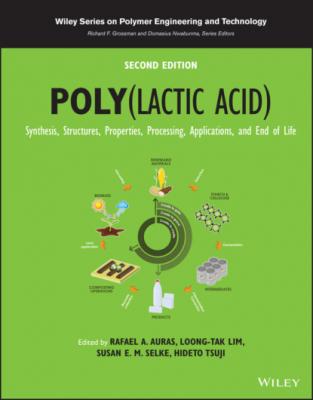Poly(lactic acid). Группа авторов
Читать онлайн.| Название | Poly(lactic acid) |
|---|---|
| Автор произведения | Группа авторов |
| Жанр | Химия |
| Серия | |
| Издательство | Химия |
| Год выпуска | 0 |
| isbn | 9781119767466 |
TABLE 2.2 Physical Properties of Lactide
| Property | Value | Isomer | Reference |
|---|---|---|---|
| Molar mass (g/mol) | 144.13 | D, L, meso, rac | — |
| Melting point (°C) | 53–54 | meso | [10] |
| 95–98 | L | [10] | |
| 95–98 | D | [10] | |
| 122–126 | rac | [10] | |
| Specific rotation L‐lactide | |||
| [α]D 20 | −266 (c 1.00 dichloromethane) | — | [11] |
| [α]D 20 | −299 (c 1.00 toluene) | — | [11] |
TABLE 2.3 Vapor Pressure of Anhydrous Lactic Acid
| T (K) | P sat (Pa) | Source | Accepted(A) or Rejected(R) |
|---|---|---|---|
| 351.15 | 13.332 | [13] | R |
| 352.65 | 39.997 | [14] | R |
| 355.15 | 66.66 | [15] | A |
| 358.15 | 133.32 | [15] | A |
| 369.15 | 133.32 | [16] | R |
| 377.15 | 599.95 | [17] | A |
| 392.15 | 1599.9 | [15] | A |
| 395.15 | 1866.5 | [15] | A |
| 395.15 | 1999.8 | [18] | A |
| 395.25 | 1599.9 | [19] | R |
| 400.65 | 2666.4 | [20] | A |
| 405.15 | 3333.1 | [21] | A |
FIGURE 2.1 Selected vapor pressures of anhydrous lactic acid selected from literature as summarized in Table 2.3.
Witzke [1] evaluated lactide vapor pressure data from a Boehringer Ingelheim patent [12], as well as data provided by Cargill. The Boehringer Ingelheim patent provides vapor pressure data and a distillation to separate meso‐lactide from D‐ and rac‐lactide. The Witzke thesis provides plots superimposing the Cargill data with the patent data but does not tabulate the Cargill data. The Boehringer Ingelheim vapor pressures are provided in the approximate range of 100 to 225°C and are represented by:
(2.2)
(2.3)
The equations and the patent data are provided in Figure 2.1. Witzke was able to reproduce the patent distillation to separate meso‐lactide from D‐ and rac‐lactide using intermediate temperatures and a high reflux ratio.
2.4 OLIGOMERIZATION IN AQUEOUS SOLUTIONS
Lactic acid exits as primarily a monomer unit in dilute aqueous solutions, nominally <20 wt%. Aqueous solutions are acidic and thus undergo equilibrium esterification. At high acid concentrations, the equilibrium shifts to the longer esters and the solution viscosity increases. The oligomerization of the lactic acid is an equilibrium‐limited reaction, dependent upon the acid and water concentrations. Two lactic acid molecules can esterify, yielding a dimer called lactoyllactic acid, L2:
The
